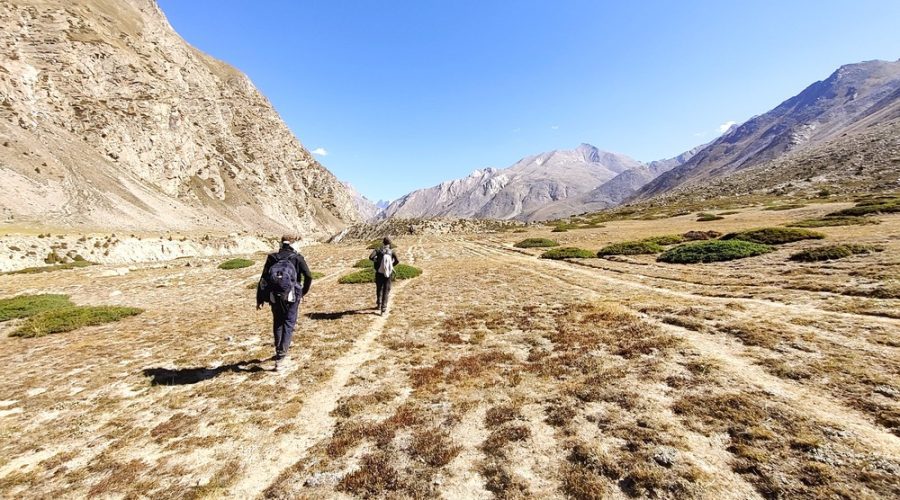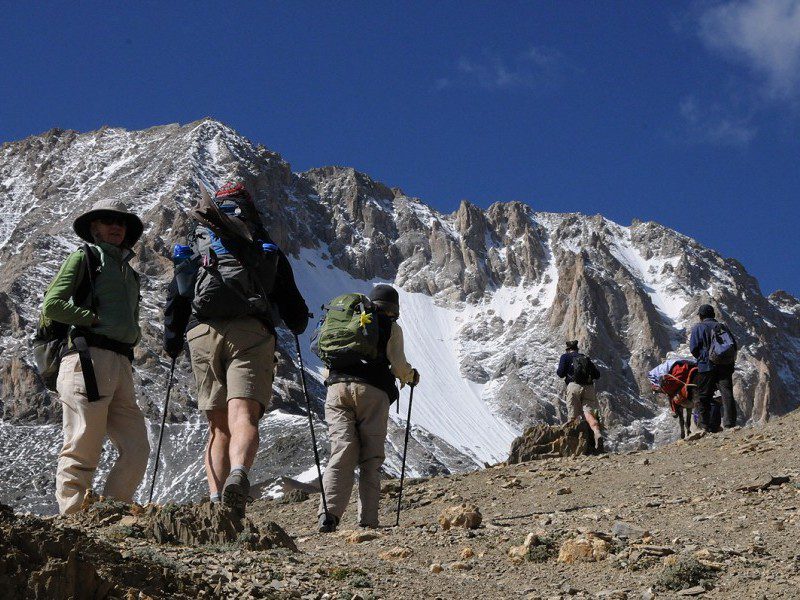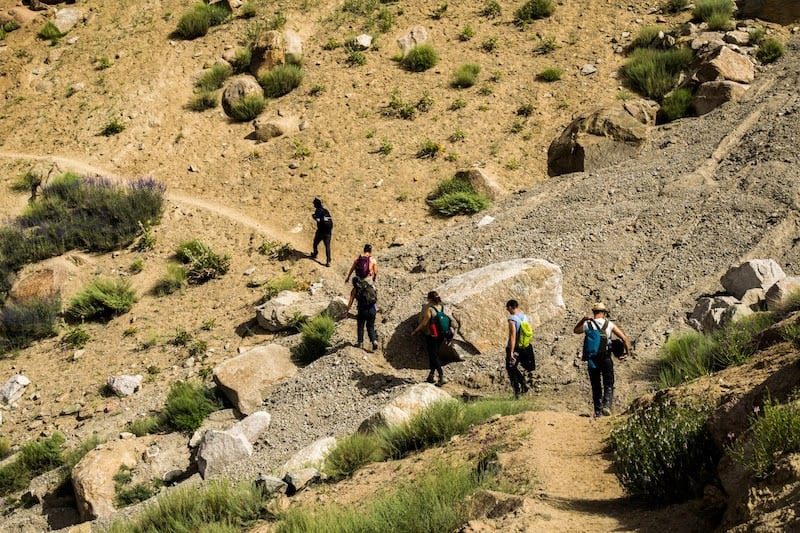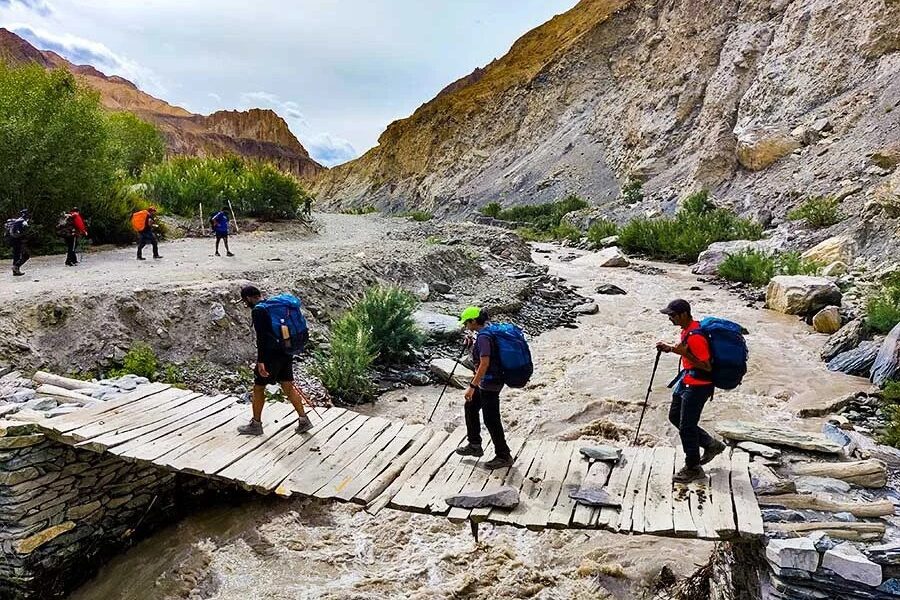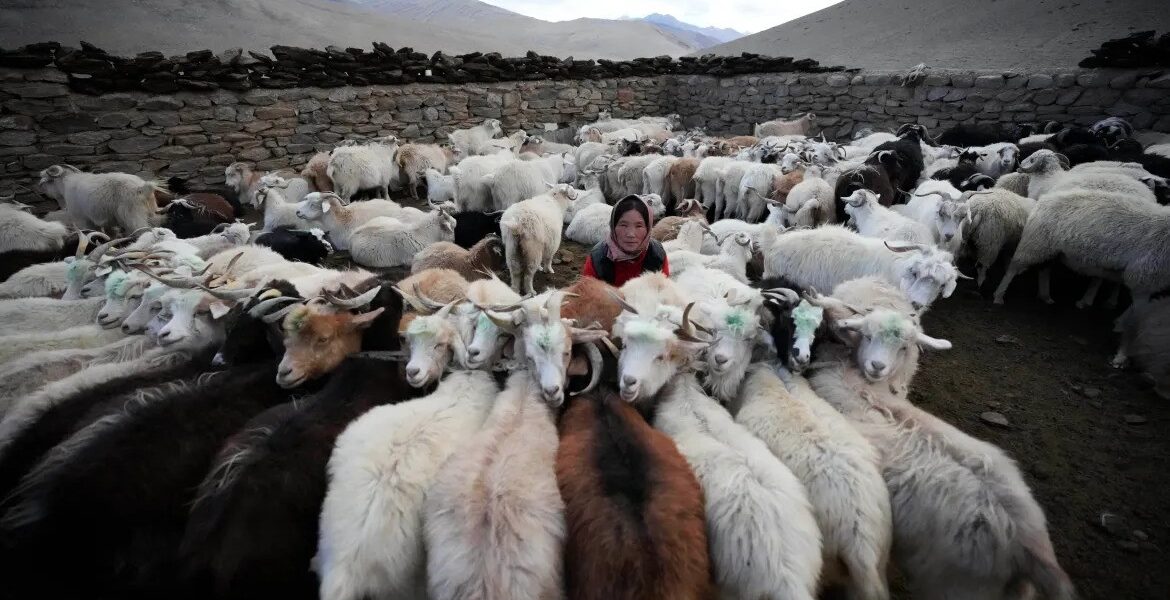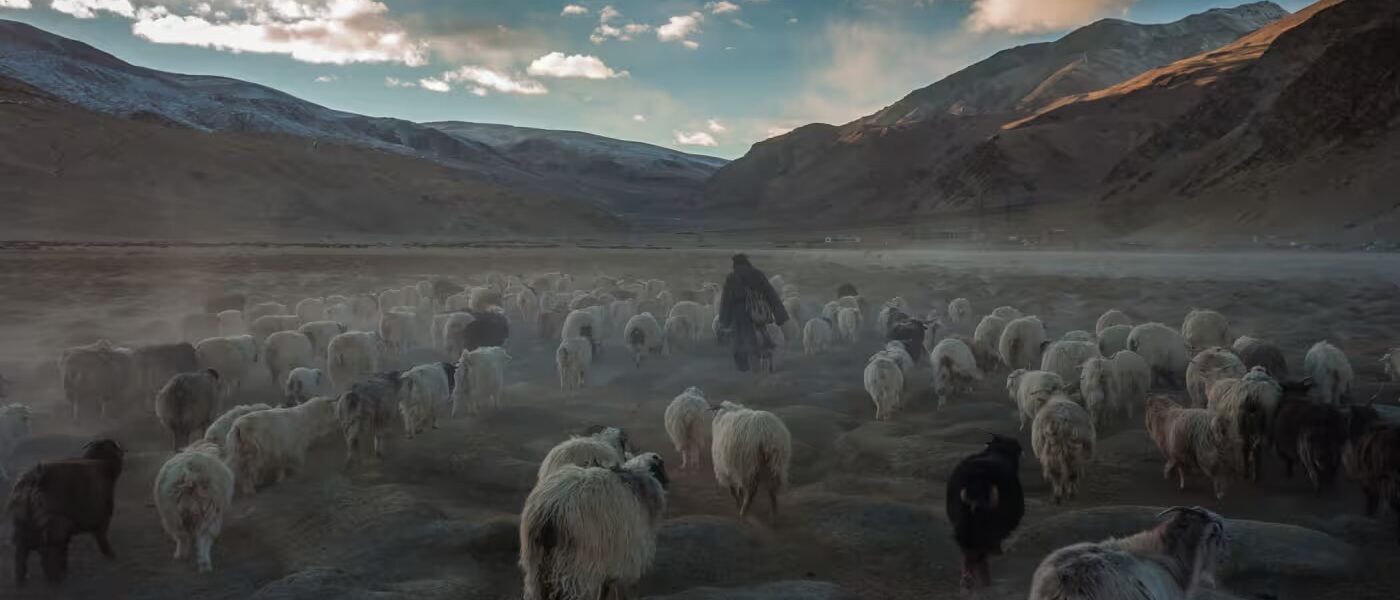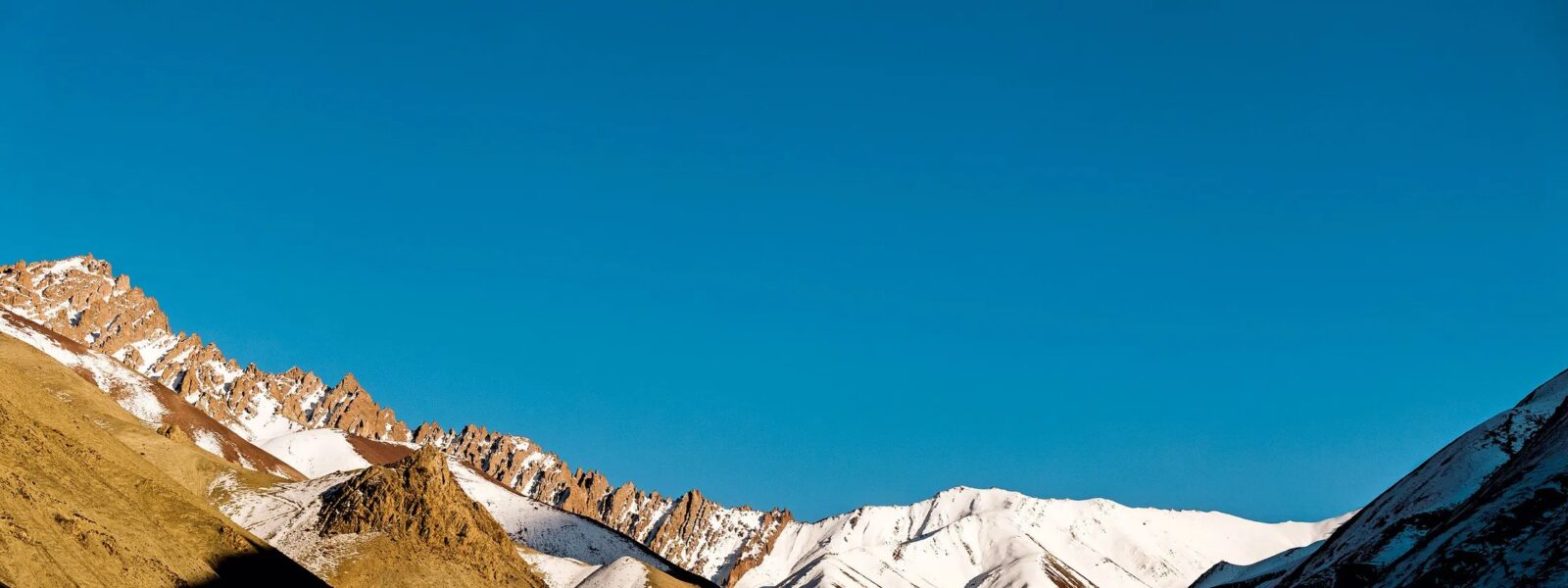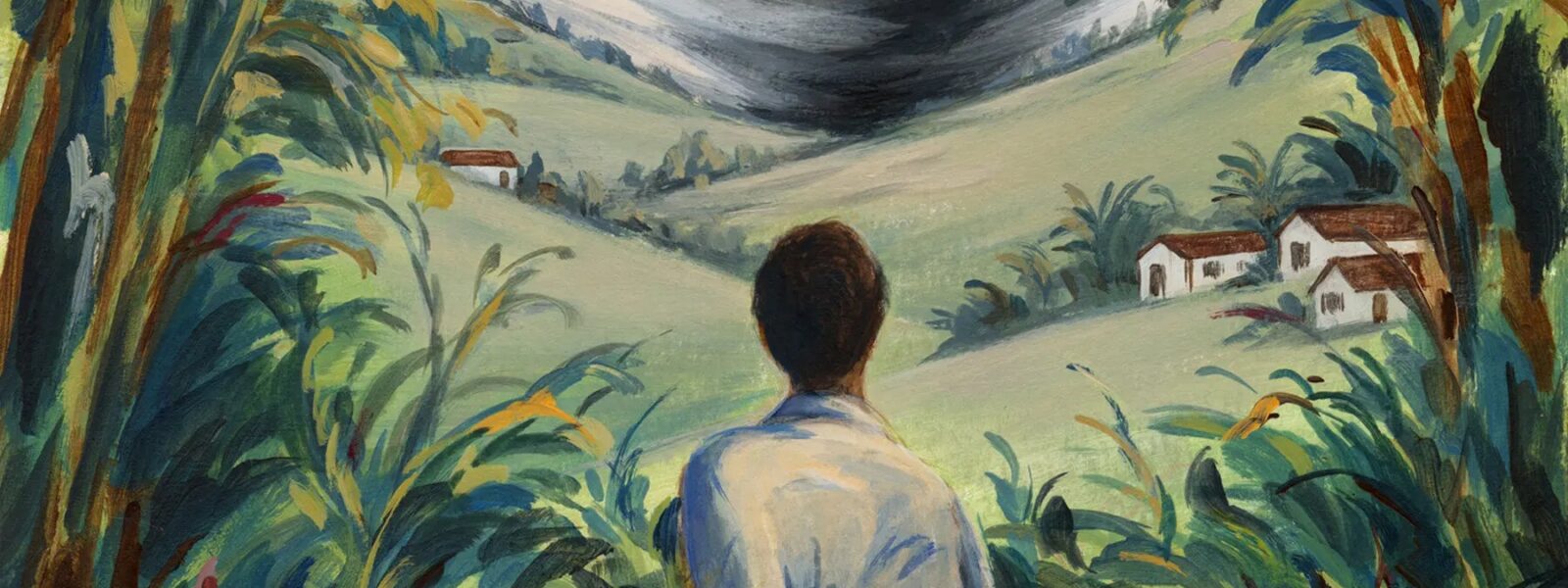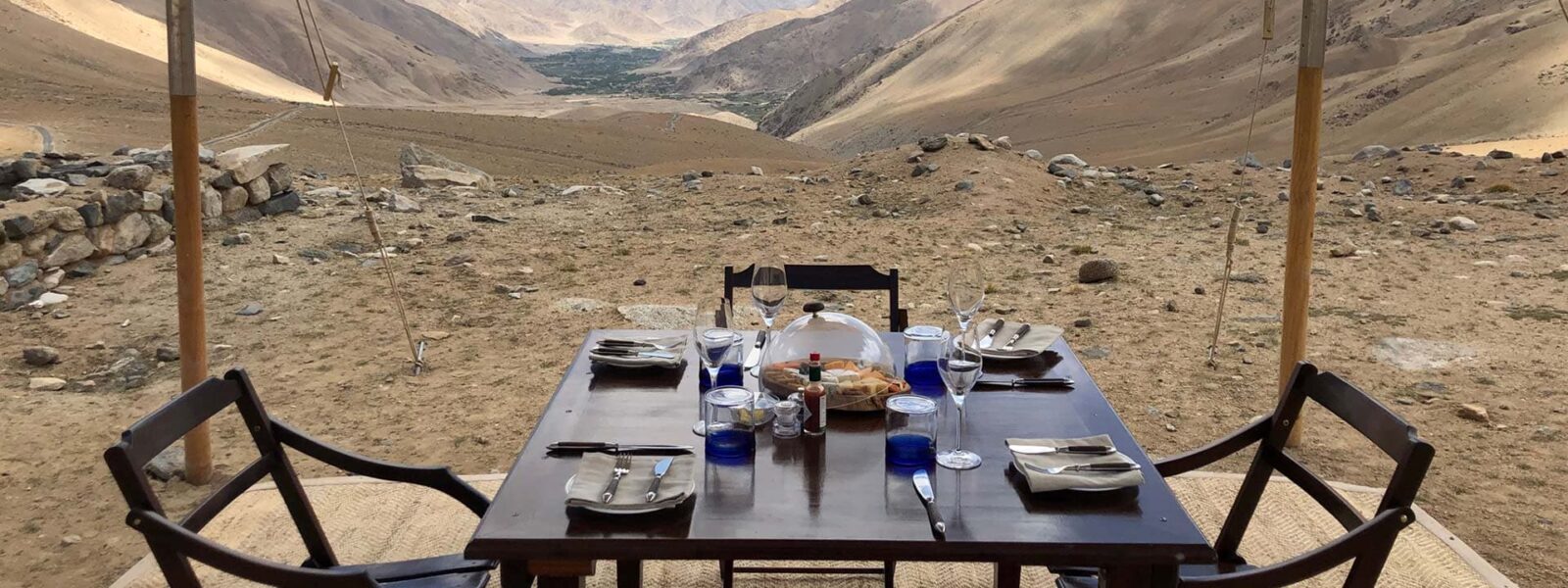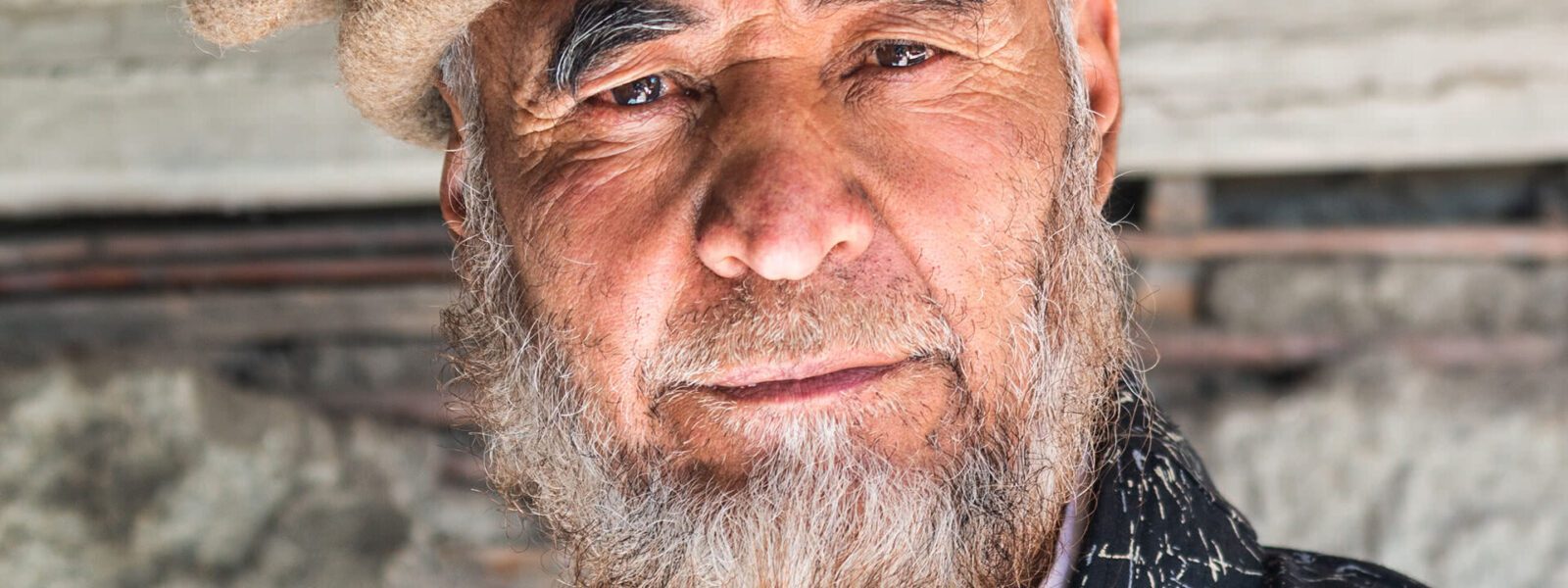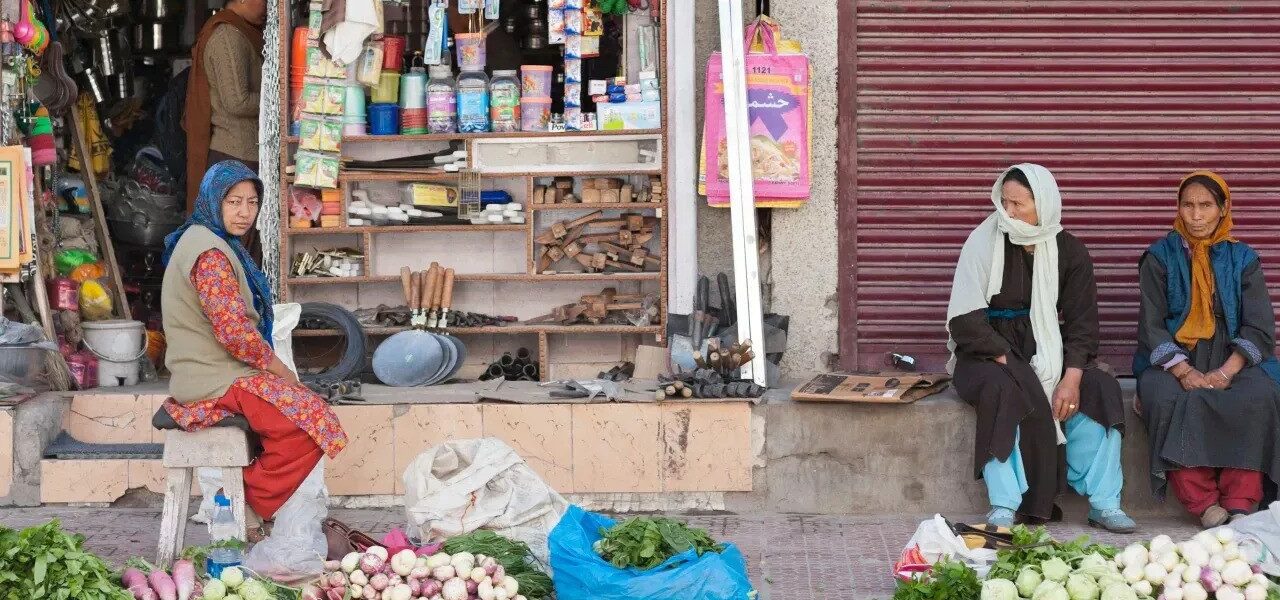Trekking Ladakh Remote Villages offers a journey that transcends the physical landscape and takes you through layers of history, culture, and tradition. Nestled in the Indian Himalayas, Ladakh’s villages provide a unique blend of rugged high-altitude treks and serene cultural immersion. From isolated hamlets to centuries-old monasteries, trekking in this region lets you experience the essence of Ladakhi life, preserved over generations.
This blog post will serve as your guide to trekking Ladakh’s remote villages—exploring their history, best routes, preparation tips, and how to make the most out of this adventure.
Introduction to Trekking in Ladakh’s Remote Villages
Why Trekking in Ladakh Is a Unique Experience
Ladakh is a region like no other. Known as the “Land of High Passes,” it features some of the most dramatic landscapes in the world—barren mountains, crystal-clear rivers, and isolated villages that appear frozen in time. Trekking through Ladakh allows you to traverse paths that have been walked for centuries, connecting remote Himalayan villages, Buddhist monasteries, and traditional Ladakhi settlements.
“Trekking in Ladakh is not just about the physical challenge; it’s a deeply spiritual experience. Passing through these remote villages and interacting with locals gave me insights into a way of life that hasn’t changed much in centuries.”
— David Wright, USA, Travel Blogger
The Historical and Cultural Significance of Ladakh’s Villages
The villages in Ladakh are home to a vibrant and ancient culture. Most of the inhabitants follow Tibetan Buddhism, which influences their way of life, architecture, and spiritual practices. Trekking through these traditional Ladakhi villages introduces you to centuries-old monasteries, prayer flags fluttering in the wind, and villagers living in harmony with nature. This cultural immersion makes trekking in Ladakh more than just an outdoor adventure—it’s a journey through time.

Best Trekking Routes Through Ladakh’s Remote Villages
Zanskar Valley: Exploring Hidden Villages
One of the most remote regions in Ladakh, the Zanskar Valley offers an adventurous trek through isolated villages like Padum, Zangla, and Lingshed. The region is known for its challenging terrain and offbeat trekking routes. As you hike through these hidden gems, you’ll discover the valley’s rich cultural heritage.
“Trekking through the Zanskar Valley was one of the most challenging yet rewarding experiences of my life. The villages felt completely untouched by modern life. It was as if I had stepped back in time.”
— Linda Johnson, Canada, Engineer
Nubra Valley Trek: A Journey Through High-Altitude Settlements
The Nubra Valley offers an entirely different trekking experience. Known for its vast landscapes, double-humped camels, and small Ladakhi hamlets, the valley takes you through a blend of deserts and lush green pastures. The trek covers villages like Diskit, Hunder, and Sumur, offering an unparalleled cultural experience.
“The Nubra Valley trek felt surreal. One day you’re trekking through sand dunes, and the next you’re in a lush valley surrounded by snow-capped peaks. The villagers welcomed us with open arms, and staying in their homes was a highlight.”
— John Richards, Australia, Software Developer
The Markha Valley Trek: Combining Adventure and Culture
For those seeking a balance between adventure and cultural immersion, the Markha Valley trek is perfect. Passing through traditional Ladakhi villages like Skiu, Hankar, and Markha, this trek offers beautiful mountain scenery and the chance to interact with locals.

“The Markha Valley trek was the perfect combination of physical challenge and cultural discovery. The villages along the way felt like little pockets of history, and the views were absolutely breathtaking.”
— Sofia Martinez, Spain, Teacher
Experiencing Ladakh’s Villages on Foot
Homestay Trekking: Connecting with Locals in Ladakh
One of the most enriching aspects of trekking in Ladakh is staying in village homestays. These accommodations allow you to experience Ladakhi hospitality first-hand, with meals made from local ingredients and evenings spent learning about village life. Opting for homestay trekking experiences in Ladakh supports sustainable tourism and helps preserve the local culture.
| Village |
Elevation (m) |
Homestay Availability |
Unique Features |
| Skiu |
3,400 |
Yes |
Traditional Ladakhi houses |
| Hemis Shukpachan |
3,600 |
Yes |
Scenic location, prayer wheels |
| Rumbak |
3,800 |
Yes |
Snow leopard sightings |
| Uleytokpo |
3,500 |
Yes |
Riverside village, peaceful |
“Staying with Ladakhi families in their homes was such a warm experience. You get a sense of what life is really like in these remote areas, and the hospitality is beyond compare.”
— Mei Ling, Singapore, Digital Nomad
Trekking with Local Guides: A Deeper Cultural Experience
Hiring a local Ladakhi guide can enhance your trekking experience by offering insights into the region’s history, culture, and landscape. These guides often come from the villages themselves, allowing you to connect with the local community in a meaningful way.
“Our local guide was incredible. He not only led us through the trekking routes but also introduced us to the villagers, explained local customs, and even shared stories about the history of the monasteries we visited.”
— Carlos Fuentes, Mexico, Geologist
Best Time for Trekking Ladakh’s Remote Villages
The best time to visit Ladakh for trekking is during the summer months, from June to September, when the weather is favorable, and the trekking trails are open. Winter trekking is possible but far more challenging due to the extreme cold and snow.

Preparing for Your Trek in Ladakh
Essential Trekking Gear for Ladakh’s High-Altitude Trails
Packing the right gear is essential for trekking at high altitudes. Below is a quick checklist for your trek through Ladakh’s remote villages:
- Sturdy trekking boots
- Layered clothing for temperature changes
- Sunscreen and sunglasses (the sun at high altitudes can be intense)
- Trekking poles
- Water purification tablets
- First aid kit
This list will ensure you’re prepared for the challenges of high-altitude trekking in Ladakh.
Acclimatization Tips for Trekking at High Altitudes
Acclimatization is crucial when trekking through Ladakh’s villages, as many of these areas are located at altitudes over 3,500 meters. To avoid altitude sickness, follow these tips:
- Ascend slowly to allow your body to adjust
- Stay hydrated
- Take rest days if needed
- Avoid alcohol and heavy meals
“I can’t stress enough the importance of acclimatization. Taking it slow made all the difference in my experience.”
— Emma Wilkins, UK, Nurse
Off-the-Beaten-Path Villages to Explore in Ladakh
Discovering Ladakh’s Secluded Hamlets
For those looking to truly get off the grid, Ladakh has numerous secluded villages that offer a raw, untouched experience. Villages like Hanle, Turtuk, and Sakti remain relatively unknown to mainstream tourists, providing a peaceful retreat for trekkers.
Wildlife and Nature Along the Trekking Routes
Spotting Wildlife in Ladakh’s Remote Regions
While trekking, you might spot some of Ladakh’s iconic wildlife, such as snow leopards, Himalayan marmots, and blue sheep. Trekking through Ladakh’s wilderness offers the unique opportunity to observe these animals in their natural habitat.
Sustainable Trekking in Ladakh
Responsible Tourism Practices While Trekking
To protect Ladakh’s fragile ecosystem, it’s essential to engage in sustainable trekking practices. These include minimizing waste, staying on designated trails, and supporting local communities by choosing homestays and buying local products.

“Sustainable tourism is the key to preserving Ladakh’s beauty. Every small action, like carrying reusable water bottles, helps protect this incredible environment.”
— Samantha Green, New Zealand, Conservationist
FAQs on Trekking Ladakh’s Remote Villages
What are the best trekking routes in Ladakh for beginners?
For beginners, routes like the Sham Valley or the Markha Valley are ideal due to their moderate difficulty and cultural experiences.
Is it safe to trek in Ladakh’s remote villages?
Yes, as long as you prepare properly, hire local guides, and acclimatize to the altitude.
How can I find local guides for trekking in Ladakh?
Local guides can be booked through trekking agencies in Leh or online before your trip.
What gear is essential for trekking in Ladakh?
Essential gear includes sturdy trekking boots, layered clothing, trekking poles, sunscreen, water purification tablets, and a first aid kit.
When is the best time for trekking in Ladakh?
The best time for trekking in Ladakh is during the summer months, from June to September, when the weather is mild and the trails are accessible.
Are there any permits required for trekking in Ladakh’s remote areas?
Yes, certain trekking routes in Ladakh require permits, especially those near sensitive border areas. These can be obtained in Leh.
Conclusion: A Journey Through Time in Ladakh’s Villages
Trekking through Ladakh’s remote villages is an extraordinary journey—one that offers more than just physical challenges. It’s an opportunity to connect with an ancient culture, explore breathtaking landscapes, and experience the warmth of Ladakhi hospitality. From the rugged Zanskar Valley to the serene Nubra Valley, every village has a story to tell, waiting for you to discover.
Trekking Ladakh Remote Villages
Trekking Ladakh Remote Villages | The journey through Ladakh mirrors the very essence of unraveling unknown horizons, as its dramatic landscapes and unique cultural identity awaken the deepest sense of wonder and exploration. Trekking Ladakh Remote Villagesdelves into this realm where inner peace intertwines with the wild, untouched beauty of Ladakh. From the snow-capped peaks to the serene monasteries, every step in Ladakh is a step toward self-discovery. The mountains, ancient paths, and unspoken mysteries stretch before travelers, offering a meditative experience where each encounter feels both effortless and transformative. Whether it’s trekking across remote valleys or sitting quietly beside a sacred lake, Ladakh invites those who seek a deeper connection to the natural and spiritual world.

The Trekking Ladakh Remote Villages’s Trekking Ladakh Remote Villages
The monasteries of Ladakh stand as living monuments to the region’s profound spiritual heritage. With origins dating back over a thousand years, these ancient structures are both places of worship and repositories of art, culture, and wisdom. Hemis Monastery, one of the largest in Ladakh, is renowned for its annual festival, featuring colorful mask dances performed by monks. The history of these monasteries reflects Ladakh’s role as a crossroads between India, Tibet, and Central Asia, where religious and cultural influences have intertwined over the centuries.
The Tibetan Buddhist influence is especially evident in the architecture and daily life of the monks. Prayer wheels, intricate murals, and the soft hum of chants fill the air as visitors explore the monastery grounds. Each monastery, from the remote Lamayuru to the awe-inspiring Thiksey, offers a window into the spiritual heart of Ladakh. These centers of meditation, learning, and community life continue to thrive, preserving traditions that have shaped Ladakh for generations.
Why Visit Ladakh for Trekking Ladakh Remote Villages?
Ladakh is a destination that transcends mere travel. It offers a journey that touches both the outer and inner landscapes, making it a perfect setting for those who seek to unravel their own unknown horizons. The region’s breathtaking scenery—from towering mountain ranges to hidden valleys—provides not just an escape but a space for contemplation and growth. Ladakh’s culture, deeply rooted in Buddhist practices, invites visitors to reflect on their own lives and the world around them.
Ladakh’s people, known for their warmth and hospitality, add to the richness of the experience. Villages like Sumda Chun and the legendary Nubra Valley introduce travelers to a way of life that is intricately connected to nature and spirituality. Staying in local homestays allows for immersive experiences where one can learn about traditional Ladakhi customs, share meals made from local produce, and participate in community rituals.

Beyond its natural beauty, Ladakh offers a unique opportunity to explore oneself. The vastness of the region’s plateaus and the clarity of its skies seem to mirror the vastness of the human spirit. Whether it’s standing atop a mountain pass at 18,000 feet or meditating in a centuries-old monastery, Ladakh helps unravel the unknown horizons within each traveler.
Finding the Best Trekking Ladakh Remote Villages in Ladakh
Finding the best places in Ladakh to experience “Trekking Ladakh Remote Villages” involves venturing off the beaten path. Ladakh’s lesser-known treks, such as those leading to secluded monasteries or high-altitude lakes, offer unparalleled opportunities for solitude and reflection. The Markha Valley trek, for instance, takes travelers through verdant valleys, ancient villages, and high-altitude passes, allowing for both physical and spiritual exploration.
Ladakh’s iconic lakes, including Pangong Tso and Tso Moriri, are ideal spots for quiet contemplation. Their still waters reflect the sky, creating a mesmerizing landscape that feels timeless and infinite. Sitting beside these lakes, especially at dawn or dusk, brings an overwhelming sense of peace and connection with nature.

For those interested in Ladakh’s spiritual heritage, exploring monasteries such as Alchi, Phyang, or Diskit can be a transformative experience. These sites are not just places of worship but also centers of art, philosophy, and wisdom. Visiting these monasteries, with their ancient murals and intricate statues, offers insight into Ladakh’s rich cultural tapestry.
Ladakh’s Atmosphere and Trekking Ladakh Remote Villages
Ladakh’s atmosphere is unlike any other place on Earth. The stark contrasts between the rugged mountains and the serene, tranquil monasteries create an environment that feels both raw and sacred. The traditional decor in Ladakhi homes and religious sites reflects this balance, with mud-brick houses adorned with prayer flags and colorful thangkas (Buddhist paintings) that add warmth and spiritual meaning to the space.

The interiors of Ladakhi homes, often simple and functional, are filled with symbols of devotion. Small shrines dedicated to Buddhist deities are common, and the air is often fragrant with incense. The use of earthy materials, like stone and wood, along with brightly colored textiles, creates an inviting and peaceful space, perfect for relaxation and reflection.
Traditional Ladakhi Cuisine
Traditional Ladakhi cuisine is an integral part of the region’s identity, offering a unique blend of flavors that reflect its harsh climate and remote location. Hearty, warming dishes such as thukpa (noodle soup) and momos (dumplings) provide the sustenance needed to endure Ladakh’s cold temperatures. Skyu, a thick stew made with root vegetables and barley, is another staple of the Ladakhi diet, designed to nourish both body and spirit.

Drinks like butter tea, made with yak butter and salt, are a must-try for anyone visiting Ladakh. This rich, savory drink is not only warming but also hydrating, making it essential for those venturing into the high-altitude regions of Ladakh. Chang, a local barley beer, is often enjoyed during festivals and community gatherings, adding a sense of joy and camaraderie to any occasion.
Live Cultural Trekking Ladakh Remote Villages in Ladakh
Ladakh is home to a vibrant cultural scene, with festivals and live performances held throughout the year. The Hemis Festival, which celebrates the birth of Guru Padmasambhava, is one of the largest and most famous events in the region. Monks dressed in elaborate costumes perform cham dances, which depict the triumph of good over evil. The energy of the festival, with its bright colors, rhythmic music, and elaborate rituals, draws visitors from around the world.
Other local festivals, such as the Losar (New Year) and Ladakh Festival, provide visitors with the chance to witness traditional dance, music, and crafts that have been passed down through generations. These events are more than just entertainment; they are a celebration of Ladakh’s rich cultural heritage and its deep connection to the spiritual world.
Trekking and Outdoor Activities Trekking Ladakh Remote Villages
Ladakh is a trekker’s paradise, offering some of the most stunning and challenging routes in the world. From the famous Trekking Ladakh Remote Villages, which follows the frozen Zanskar River, to lesser-known routes like the Sham Valley or Nubra Valley treks, Ladakh’s landscape offers endless possibilities for adventure and discovery. The high-altitude passes, such as Khardung La and Chang La, offer breathtaking views of snow-capped peaks and sprawling valleys.

Wildlife enthusiasts will also find Trekking Ladakh Remote Villages to be a haven for rare species such as the snow leopard, Himalayan blue sheep, and the Tibetan wild ass. Winter expeditions to spot the elusive snow leopard in the Hemis National Park are gaining popularity among wildlife photographers and conservationists alike.
The Importance of Preserving Ladakh’s Trekking Ladakh Remote Villages
Ladakh’s rich cultural and environmental Trekking Ladakh Remote Villages is under increasing threat from climate change and mass tourism. Preserving this unique region requires careful attention to sustainable tourism practices. Choosing eco-friendly accommodations, supporting local businesses, and participating in community-led conservation efforts are just a few ways that visitors can contribute to the preservation of Ladakh’s natural and cultural heritage.
Ladakh’s people have a long history of living in harmony with their environment, practicing sustainable agriculture, and maintaining a deep spiritual connection to the land. Visitors are encouraged to follow the same principles, leaving no trace and respecting the fragile ecosystems that make Ladakh so special.
Etiquette and Tips for Visiting Trekking Ladakh Remote Villages
Before visiting Ladakh, it’s essential to understand and respect the region’s customs and traditions. As a deeply spiritual place, Ladakh requires visitors to dress modestly, especially when visiting monasteries or attending religious ceremonies. Always ask for permission before taking photographs inside monasteries or of local people.
Medical Trekking Ladakh Remote Villages
Spa trail Trekking Ladakh Remote Villages
Trekking Ladakh Remote Villages

When Trekking Ladakh Remote Villages, remember to stay on designated paths to avoid damaging fragile ecosystems. Tipping is appreciated but not expected in most settings, and it’s important to carry cash, as many remote areas do not accept credit cards. Lastly, be mindful of altitude sickness and take the necessary precautions when traveling to higher elevations.
Conclusion: Enjoying Trekking Ladakh Remote Villages in Ladakh
Ladakh is a place where the physical and spiritual worlds converge, offering travelers a journey unlike any other. Whether you’re trekking across high-altitude deserts, exploring ancient monasteries, or simply sitting in quiet reflection by a mountain lake, Ladakh invites you to unravel your own unknown horizons. By respecting the region’s traditions and practicing sustainable tourism, you help ensure that Ladakh’s beauty and cultural richness will be preserved for future generations to explore and enjoy.

